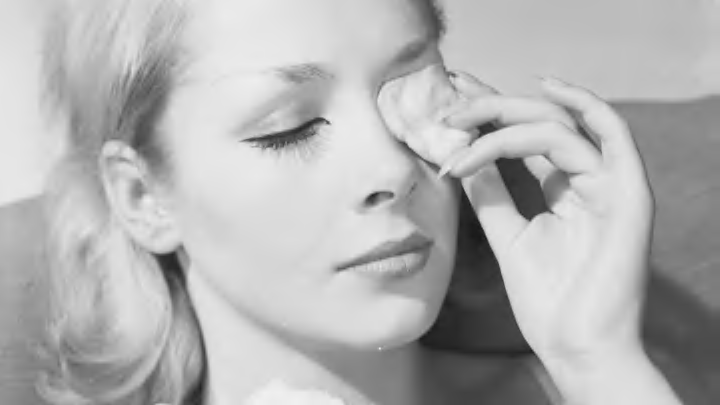Before the advent of modern moisturizers, people came up with a lot of creative (and often horrifying) ways to soften their skin. Here are some of the strangest things people have ever slathered on in the quest for smoothness.
Coal Tar Residue
There’s nothing like a dash of carcinogens to spice up your skin care routine. In 2011, researchers examined a cosmetic flask they believe belonged to the female Egyptian pharaoh Hatshepsut. Inside, they found traces of harmless moisturizers like palm and nutmeg oils. But the vial also contained the residue of an aromatic yet deadly chemical called benzo(a)pyrene, one of the most dangerous carcinogens in cigarette smoke and a byproduct of burning coal tar. Repeated application of the substance, which can be absorbed through the skin, “has been demonstrated to induce skin tumors in guinea pigs, rabbits, rats, and mice,” according to the EPA. Researchers believe Hatshepsut died of cancer in 1458 BCE. They say it's possible her dangerous skin cream played a role.
Chicken Blood

People in ancient China invented a number of skin-softening concoctions. One unusual recipe called for dried peach blossoms and the blood of a black chicken. Mashed into a paste and applied as a face mask, this gruesome mixture supposedly nourished and lightened the skin. It was reportedly a favorite beauty treatment of Princess Taiping, who lived during the Tang and Zhou Dynasties in the mid 7th and early 8th centuries CE.
Crocodile Dung
Elegant ladies in ancient Rome kept their faces looking fresh with a few dabs of crocodile poop. “Dainty women highly prize the dung of land crocodiles,” wrote Galen, a 3rd century CE Roman physician and philosopher. “For such women it is not enough that there are countless other cosmetics by which their faces are made smooth and shiny.”
Bread and Milk

Some women in ancient Greece relaxed before bedtime with a facial of mashed bread and milk, which was thought to keep the skin soft and youthful. Many Roman women also made face masks from bread crumbs soaked in milk. Sometimes they left the masks on all day, and only washed them off if they had to run an errand.
Wine Dregs
When they weren’t indulging in bread crumb face masks, some women in ancient Rome covered their skin in the dregs of wine vats. They believed this fermented sludge made their skin smoother.
Mercury

A 19th-century British encyclopedia of medicinal remedies contains a recipe for a skin ointment called Gowland’s Lotion, intended as a “beautifier of the complexion.” The recipe calls for crushed almonds, water, and powdered “corrosive sublimate”—also known as mercuric chloride, the very poisonous chemical compound of mercury and chloride. It seems the encyclopedia’s author, Arnold James Cooley, was somewhat aware of this lotion’s toxicity; he didn’t recommend leaving it on the skin for too long. “It is employed by wetting the skin with it, either by means of the corner of a napkin or the fingers dipped into it,” he explained. “It is then gently wiped off with a dry cloth.”
Honey
Hippocrates, the ancient Greek physician known as the father of modern medicine, swore by the moisturizing powers of honey. He claimed it “assures a fresh and jovial look” when applied to the face. He wasn’t the only one slapping on the sticky substance; at the time, honey was a popular moisturizer and exfoliator throughout the Mediterranean region.
Animal Fat

In 2003, archaeologists unearthed a canister of white skin cream at an ancient Roman temple in Southwark, London. Incredibly, the ointment inside was still wet, and it bore the fingerprints of the person who had used it during the 2nd century CE. A chemical analysis of the cream revealed that it mainly consisted of animal fat from either cattle or sheep. Once they knew the chemical breakdown of the cream, a team of scientists at the University of Bristol whipped up a new batch of the moisturizer to try for themselves. “This cream had a pleasant texture when rubbed into the skin,” they noted.
Discover More Tales from Medical History:
A version of this story was published in 2016; it has been updated for 2025.
